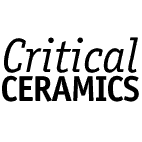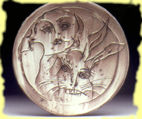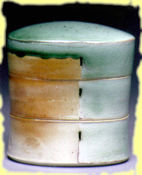
Click to learn more about sponsorship...




Sam Chung


Sam Chung


Ron Meyers
Victor M. Cassidy
For many years, potters have sprayed salt or soda solutions into kilns as the temperature was rising. Depending on the artist, the kiln, and the amount of chemical used, atmospheric firing can produce a matte or orange peel finish and attractive blushes of color. Fumes from salt firing contain hydrochloric acid, which is toxic to humans and the environment. Many artists now favor the similar, but more benign, soda firing technique.
What is your experience with salt and soda firing? What does it do for you expressively? Critical Ceramics put these questions to Sam Chung, Maren Kloppmann, and Ron Meyers. All three artists recently showed in a big group exhibition at Chicago’s Lill Street Studios.*
Incredible Variation
Everyone agrees that salt/soda firing means less control for the artist, which can be a good thing. “The soda kiln gives me an incredible variation from one firing to another,” says Kloppmann. “Soda alters the surface subtly, leaves a very small trace. I walk a strange line between having control and giving it up. There’s always some accident in the process.”
Chung calls soda firing “uncontrollable.” Raw clay “becomes shiny wherever the soda touches it,” he states. “The way soda reacts with the piece is very localized. Where to place greenware in the kiln becomes an issue.”
He adds that where to spray the soda solution is equally important because “the fume follows the circulation of the flame.” He sprays in eight different places in the kiln and thinks that an artist’s knowledge of their kiln should guide these decisions.
Chung’s elegant work is decorated with subdued colors and a crackle glaze. “I got into salt/soda firing the way most artists do,” he states. “When I used regular glazes, I got predictable results. After college, I wanted something different, wanted mystery.
“My whole reason for changing,” he continues, “was to emphasize the forms in my work. Soda fluxes the glaze and fades the color around the edges to intensify the linear quality of the work.”
Just a Little Shine
Ron Meyers started salt firing because he wanted to make his painted earthenware more expressive. “People saw only the image in my work, not the form,” he says. “High temperature salt firing gives a wet look—just a little shine—that gets me away from pretty transparent glazes. Salt firing softened my colors and I started to draw more directly into the clay. Recently I went to low temperature firing.”
Meyers has worked with both salt and soda atmospheres. “At one point I started using soda in my kiln, found that it was caustic to the bricks, and went back to salt,” he states. “Results from atmospheric firing vary depending on where you put the piece in the kiln. You get a darker finish in the back, a warmer finish at the front.”
Meyers often incises drawings of animals into the surfaces of his vessels. Some pieces incorporate animal forms, like the frog-shaped handles on his Tureen. He favors quiet colors like tan, dark orange, and cream. Though influenced by Oriental art, he is more funky than formal.
We see the hand everywhere in Meyers’ roughly slip finished vessels. “I don’t want to make a perfect pot,” he says. “I put my hands all over it so my process shows. The cats, mice, frogs, and birds on my vessels are part of my personal history. I have always taken an interest in Kingfishers and like their personality.”
Go For It
Oriental in form, Maren Kloppmann’s ceramics are decorated with blushes of color and a crackle glaze. Some surfaces have white streaks brushed on them. Tiny rectangular holes piercing the work suggest windows or doorways.
“I combine glaze and Terra-Sigillata to get those surfaces and blushes,” says the artist. “I spray very small amounts of soda into the kiln. It is carried through the flame onto the piece. Soda gives me subtle color variations. It substitutes for salt firing, which harms the environment.”
Terra-Sigillata, which dates from Greek and Roman times, is a blend of superfine clays that the artist brushes on greenware as a thin slip. “It sits on the surface and maintains a sheen,” she says. “But beyond a certain point, you cannot really control what you get.”
Kloppmann has developed under European, American, and Oriental influences. She came to the United States from her native Germany at the age of 22 and was exposed to contemporary American ceramics. She admires the “simple way that Scandinavian clay artists put together a few visual elements” and is drawn to the “serenity and simplicity” of Noguchi and Brancusi. Acknowledging the architectural element in her ceramics, she explains that she studied mixed media with a Japanese architecture teacher after she had been making pottery for about a decade.
When we asked Kloppmann what advice she would give to artists who are just starting out with salt/soda firing, she said: “Go through every technique, learn by doing, then choose what’s best for you. I was very lucky in my education,” she adds, “because my teachers made me try everything.” “Go for it,” says Chung. “Try it every way you can and learn your kiln. You will discover how to adjust the atmosphere by changing the amount of oxygen or soda. You will find that some glazes give brighter colors and that a soda atmosphere delivers softer colors than salt.”
Chung told us what he wants people to see “something beautiful and timeless” when they look at his vessels. “My work is classic forms reseen,” he states. “There are thousands of years of history attached to ceramic art.”
* SALT & SODA: Vessels From Atmospheric Kilns ran from March 27 to April 25, 1999 at Gallery 1021: Lill Street Studios, Chicago. Exhibiting artists were Margaret Bohls, Sam Chung, Sam Clarkson, Julia Galloway, Tina Gebhart, Bill Griffith, Fred Johnston, Maren Kloppmann, Eva Kwong, Mary Law, Suze Lindsay, Matt Long, Linda McFarling, Matthew Metz, Ron Meyers, Jess Parker, Mark Peters, Gay Smith, and Nancy Utterback.

Ron Meyers


Maren Kloppmann


Maren Kloppmann